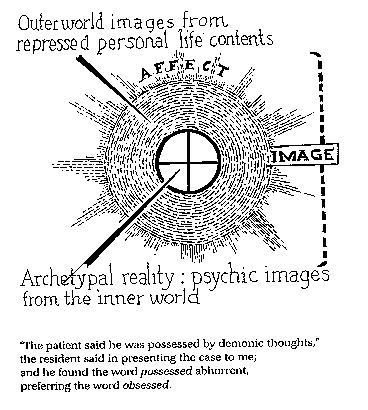
The world of archetypes is the invisible world that we have never seen. Hypothesized to be the deepest realm of the psyche which has the potential to evoke images of a more or less predictable nature. They keep recurring world-wide in all people's psyche and have been reappearing from time immemorial. We know them from myths, Faery tales, sagas, legends and stories told the world over.
Images and events which are foreign and antithetical to science are at home in the souls - the quest for the treasure in a place hard to find that is guarded by powerful mysterial forces capable of casting spells, superhumans, supernatural beings, gods and goddesses, heroes and prophets. The psychic land where these potential forms exist is the collective unconscious. From it arise our inner objective experiences, our wisdom and our folly which are objective because they are not of our own lives or subjective. It is the realm of inherited psychic instincts and behavioral patterns.
The archetype is experienced in projections, powerful affect images, symbols, moods, behaviour patterns such as rituals, ceremonials and love. Jung compared the archetype, the pre-formed tendency to create images, to a dry river bed; rain gives form and direction to the flow, we name the river, but it is never a thing located in any place, it is a form but never the same, it is always changing but it is a river and we know that rivers ultimately flow into oceans, which is symbolic of the unconscious.
On another occasion Jung compared the archetype to a supersaturated solution which, at a given point in time, forms specific crystals around a nidus, breeding formations that are characteristic of that kind of supersaturated liquid and no other. One could compare such an archetype to the mythical King Midas and speak of the nidus of Midas. A nidus doesn't exist as a thing but as a powerful potential, a representative of the archetype.

The archetypal idea when actualized and experienced becomes a complex of ideas held together by the feeling tone common to all the individual ideas. Jung observed that there was prolonged time delay in responding to charged words associated with crucial conflicts. Complexes interfere with conscious performance - action, will, memory and associations.
A complex, according to Jung is the sum of all the associated ideas and feelings that are attracted to an archetype. The complex gives the archetype a form of expression, complex is powered by affect and it is feeling this affect which tells us that we are experiencing an archetype. Therefore archetype images are among the highest values of the human psyche and treasures of the motifs of mythology. Symbols are infinitely variable expressions of underlying archetypes and collective archetypes endow the personal individual with strong affect. The archetype is a tendency to form motifs; they are not inherited images but forms to which our culture and life experience give substance. They are a priori patterns for universal symbols that are characteristic of eternal human nature. The archetypal content of powerful language is metaphor. The metaphor, like the archetype, is an organizing symbol that facilitates depth of meaning. The form in which an archetype appears if a projection clothed and formed according to one's personal life experiences that are drawn from conscious and repressed unconscious elements.
"In the Seventh Book of Republic Plato tells of his famous parable of the cave as an illustration of his theory of eternal Ideas or Forms: man is compared to a creature living in a cave, bound immovably hand and foot. At his back is the entrance to the cave and all he can see are the shadows of the forms passing outside thrown on the wall in front of him �., mistakenly he believes the shadows to be the real things." Jung.
Jungians speak of being possessed by an archetype. In ancient times people spoke of being possessed by demons or Gods, now we make psychiatric diagnoses. Nevertheless people are possessed from time to time by mysterious invading power. To be possessed by an archetype image you are an inquisitor, or a Shi'ite Moslem terrorist, or a Nazi in Germany, or an Aztec sacrificer of human beings; or Dante seeing Beatrice, or first falling in love, or Mozart hearing the concerto in D minor, or you are in your most wonderful dream or most heroic fantasy.
The unconscious is not a demonical monster but a natural entity which as far as moral sense, aesthetic sense and intellectual judgement go is completely neutral. It only becomes dangerous when our conscious attitude to it is hopelessly wrong to the degree that we repress it, its danger increases. The inner world has two realms, the personal subjective unconscious which is what Freud called the unconscious, and the collective objective unconscious which Jung discovered. The personal unconscious is inhabited by images, memories, feelings and ideas which were once conscious but are now repressed, meaning not directly accessible to consciousness. The unconscious contains the whole range of our experiences from our noblest to our darkest. The collective unconscious is inhabited by motifs, ideas, images, personalities, moods, places, visions and spirits we have never known in day-to-day life, this we were born with. We psychologically create our personal unconscious after birth. We are not born with a clean slate in our mind, just as the biological nature of a person comes 'ready made' so does the psyche. At the interface between personal and collective psyche is the reflection of the archaic world still within us and the interface between consciousness and the personal unconscious is the shadowy realm of pre-consciousness where flows the river of the unconscious, the formless dreams that float through our minds when we are awake and when we are asleep. We can dip into this 'twilight' zone through meditation, deep thought and effortless reflection. Between consciousness and the outer world we interpose our persona. Our lives are directed by the motif powers of the unconscious more than we like to think.
The psychological 'types' are a part of broader dynamics of psychic energy which involve four archetypal figures. These figures work together in pairs, one of which is conscious and compensated by its unconscious counterpart.
The first pair is 'ego' and 'shadow'. The 'ego' is the fragile, precious light of consciousness that must be guarded and cultivated. A healthy 'ego' organizes and balances the conscious and unconscious elements of the psyche; a weakened 'ego' leaves an individual in the dark, in danger of being swamped by chaotic, unconscious images, the 'ego' is the sense of purpose and identity. The 'shadow', which is always of the same sex, is the dark side of the person, characterized by inferior, uncivilized or animal qualities which the 'ego' wishes to hide from others. It is not wholly bad however, but primitive and unadapted; it can vitalize life if honestly faced up to.
Wherever good is, is evil, wherever shadow is, is light and substance. Shadow is the name of the archetype of the alter ego. It is more or less synonymous with what Freud called the unconscious but it is both personal and non-personal, 'I' and 'Not I'. We first know the shadow as the personal unconscious; all that we abhor, deny and repress, such as power, greed, cruel and murderous thoughts, unacceptable impulses and morally and ethically wrong actions, all the demonic things by which human beings betray their inhumanity to other beings. It is unconscious therefore we encounter it in other people, things and places where we project it. They have a fateful attraction to it, it seems that we have discovered where the bad stuff really is in someone else or somewhere else. But in the still depth of the collective unconscious dwells absolute evil; its model is hell, purgatory, pure torture, fiendish torment, terrorism indeed so dark we know they are malevolent, heartless and diabolical; it flourishes in mobs, in soccer games gone murderous, atrocities, war. Jung saw the Nazi holocaust as epidemic insanity, the eruption of collective evil into a deceptively ordered world. The Jews were the German shadow and became its scapegoats. This evil shadow still lurks in contemporary humanity and we are all capable of such regression.
"When evil breaks at any point in the order of things our whole circle of psychic protection is disrupted, action inevitably calls up reaction and in the matter of destructiveness this turns out to be just as bad as the crime and possibly even worse, because the evil must be exterminated root and branch. In order to escape the contaminating touch of evil we need a proper rite de sortie, a solemn admission of guilt by judge, hangman and public, followed by expiation".
"The terrible things that happened in Germany and the moral downfall of a nation of eighty millions are a blow aimed at all Europeans �"
"It has filled us with horror to realize all that man is capable of and of which therefore we too are capable. Since then a terrible doubt about humanity and about ourselves gnaws at our hearts". (Jung).
Almost everyone has at least one particularly hated person and this hated one is a remarkable clue to the most unpleasant parts of the hating one. When someone feels you are stupid, greedy, self-centred, power-driven, or thinks that you are the God who knows everything, he has put his finger on his own shadow. The shadow is inexhaustible. It is advisable to be able to eat your own shadow. If you can stomach your own shadow you can take on almost anything.
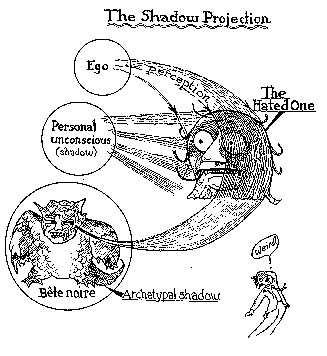
There is such a thing as a positive shadow which eats the negative shadow. In ancient Rome it was the custom of the conquering hero to ride triumphantly through the city, while by his side a wise man whispered into the hero's ear over and over "you are mortal, remember, you are mortal".
Jung writes in a letter:
"If Job succeeds in swallowing his shadow he will be deeply ashamed of the things which happened. He will see that he has only to accuse himself for it is his complacency, high righteousness, his literal mindedness which have brought all evil down upon him".
One of the problems of recognizing and facing our shadow, owning it and eating it and withdrawing it from projection is that the shadow becomes a serious problem to oneself. Withdrawing and acknowledging our shadow is only the first step, then there is long, painful negotiation with it. But it is quite obvious from dreams that when one faces a shadow which one has denied or run from, it diminishes in power and size and becomes a positive force.
"Our friends show us what we can do, our enemies teach us what we must do". (Goethe).
When we finally bring ourselves to see the shadow which we project as our own, we are literally appalled and overwhelmed by it - the evil out there is so plain to see. At the moment of taking it back within ourselves we are apt to be filled with self-recrimination, guilt and depression, no wonder we wanted to hang it on someone else. We withdraw our projection and our own shadow then becomes enormous, but after prolonged negotiation we are able to befriend the shadow. Even then it is not over because the shadow will always be there, part of our psyche. It is best if we make a truce with it for the shadow alerts us to particular kinds of danger or evil, it is our personal and collective ASIO. Others also have their shadow and they are hooks on which we hang our shadows. This does not liberate us from recognizing the legitimate shadows of the other, only now we know whose is whose. We do not have to be paranoid to have enemies, paranoia is projection of hatred and evil, almost anywhere, even without hooks.
Although the 'ego' is the centre of consciousness, it should not be confused with the 'Self' which is the final goal of the individuation process, the 'wholeness' of personality. The 'ego' which identifies with the 'Self' becomes inflated, dangerously 'God-like'. It will project its own irrational shadow onto others and identify them as evil. Jung regarded the mass psychosis of Hitler's Nazi Germany and its genocidal atrocities as occurring because the German 'ego' became inflated through its identification with the pure Aryan race and projected its collective shadow onto the Jews.
The individual patient in the early stages of Jungian analysis, who encounters the 'shadow', faces a crisis. The more he recognizes and withdraws from the 'shadow' projections the more he feels his 'ego' threatened. He begins to realize that whatever is wrong with the world is in himself and that he must learn to deal with his own 'shadow' and then be able to do something real for the world. Jung regarded the psyche as not confined to individuals only, but as also having a collective nature structured in the same way as the individual. This collective psyche formed the Zeitgeist or 'spirit of the age'. One example is the collective psyche shadow seen in Nazi Germany but it can be seen in any mass movement, trend or following, e.g. uncontrolled hooliganism at soccer matches.
The second pair is that of the 'persona' and the 'soul' image. The 'ego' is related to what Jung calls the 'persona', that part of consciousness which negotiates with the outer world on the ego's behalf. It is the 'face' we wear for society, conditioned by social class, job, culture and nationality, with often different 'personas' to suit different situations.
In Greek drama actors wore masks that turned them into the Dramatis Persone the actor becomes the person impersonated; the persona is the guise and manifestation of the role which disguises the personality of the actor.
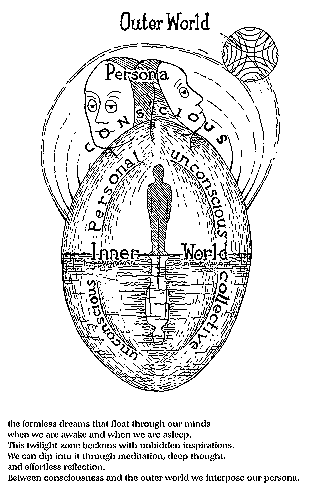
The persona is an archetype; it is a functional complex that is necessary for adaptation to interpersonal relations, it is a show to show others the role we impersonate, it is a compromise between what we wish to be and what the surrounding world will allow us to be, it is the manifestation of interactional demands.
However the persona also conceals our true nature and disguises both our shadow and our finest ideals as it tries to approximate our ego ideal. The preacher may have one persona in the pulpit and another at home with his wife and children. The way we dress, move, talk, stand, the way we outwardly do everything is our persona. It is preferable to have only a few personae at our beck and call, two conspicuous ones are optimal, work and home, but if we have too many persona people will not know how to identify the one behind the mask.
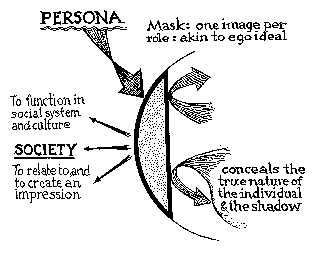
In Jungian psychology self-realization and becoming who it is in you to become have a high priority. We are running the risk of becoming a society whittled down to mediocrity, honed to conformity and valued in statistical averages. We are becoming computerized, monopolized, bureaucratized; we are become hero worshippers at the temple of sham.
"Since it was man's unfitness - his being an outcast and an outsider on this planet - which started him on this unique course, it should not seem anomalous that misfits and outsiders are often in the forefront of human endeavour and the first to grapple with the unknown. The impulse to escape an untenable situation often prompts human beings not to shrink back, but to plunge ahead; moreover it is in accord with the uniqueness of the human pattern that the misfits of the species should try to fit in, not by changing themselves, but by changing the world � It is the unique glory of the human species that its rejected do not fall by the wayside but become the building stones of the new, that those who cannot fit into the present should become the shapers of the future". (Hoffer, Ordeal Of Change).
The 'persona' adopted is based on our superior functional type because it comes easier. Psychic health and equilibrium depend on a well adapted 'persona' because it makes social exchange possible, even the 'persona' of the rebel. The danger is in identifying totally with the 'persona' being nothing but the role one plays. The perfect 'persona' can lead to one-sided, rigid and alienated personality, where they are afraid of dropping the mask and finding nothing real behind it. Neurosis can arrive from wrong answers to life, from empty success and confinement with too narrow a spiritual horizon. It generally disappears by developing into a more spacious personality.
The unconscious side of the 'persona' is the 'soul' image. Jung used the Latin male and female names for the 'soul', animus and anima. The 'soul' image is always represented by the individual's opposite gender, the female anima in man, the male animus in woman. The 'soul' image is an archetype representing the whole of the unconscious, which is inherited, collective and ageless, but modified by ones actual experience of the opposite sex, especially parents. 'Soul' images appear in dreams, myths and fantasies, but they are also projected, giving a distorted impression of individuals of the opposite sex. The male's 'soul' image, the anima, appeared in many forms throughout the ages but always with the compelling and fascinating secret nature of Eros (love) as an archetype of life itself represented in images of earth and water. The woman's 'soul' image takes the nature of Logos (reason), a search for knowledge, truth and meaningful activity, often represented by images of air and fire. It is often projected onto men with whom the woman is emotionally involved e.g. father figures in a young woman, heroic men as she matures and comforting males as doctors or priests as she grows old.
Jung called Eros the great binder and deliverer and he anticipated a growing awareness of the androgynous aspect of our personalities. Each of us is both male and female; the unisex movement is an unfortunate extreme denial of the macho and the belle and a blurring of the contrasexual being as well. Man is not all man, woman is not all woman, the homosexual personality often infuriates individuals who deny like crazy anything but their conscious heterosexual life, hating and despising being reminded that within them is the personality of the opposite sex. This concept of anima and animus with a balance of both archetypes within the same person breaks with Freud's patriarchal concept of women as flawed, castrated males with penis envy.
However this animus/anima hypothesis is only partly the case. A man with dominant feeling function can be consciously Eros and a woman with dominant thinking function can be consciously Logos. An extreme feminist who projects negative animus onto the hated male seems to be the very image of the sexist male who projects negative anima onto the dangerous female. The misogynous male sees the hated female as his projection. There is always a hook on which to hang a projection but in essence it is a case of hating oneself, the projection of ones own contrasexual being. In love we love that part of ourselves which fits the other, until we see where it does not fit.
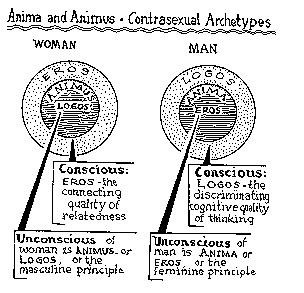
However, the contrasexual sides are not male and female but masculine and feminine principles for archetypes. Note also that the anima and the animus contain both positive and negative sides. The positive animus qualities of a woman are assertiveness, control, thoughtful, rational and strong compassionate behaviour; the negative animus qualities of a woman are opinionated, always gets the last word, ruthless and destructive. The positive anima qualities of a man are tenderness, patience, consideration, kindness and compassion; the negative anima qualities of a man are vanity, moodiness, bitchiness, and easily hurt feelings. However the Eros/Logos and Logos/Eros qualities do not always strictly distinguish the sexes, nor did Jung really say that they did, but unfortunately we are stuck with the male/female, masculine/feminine stereotypes.